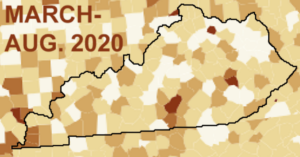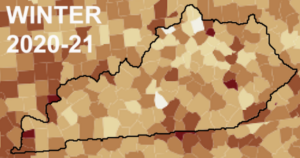Excess Covid-19 deaths grew in 2nd year despite vaccines; study cites shortage of rural vaccinations; Ky. fared worst during Delta

By Al Cross
Kentucky Health News
Scientists generally believe that the number of deaths attributed to the Covid-19 pandemic has been understated, and they point to what they call “excess deaths,” the number of deaths above the number that would have been expected if the pandemic hadn’t occurred, based on recent trends. A new study shows that excess deaths in the U.S. increased in the second year of the pandemic even though that is when Covid-19 vaccines became widely available, and that they went up largely because of increases in rural counties, where fewer people were vaccinated.
“In rural counties across the United States—where vaccines were harder to obtain, where vaccine skepticism remained higher, and where access to good health care is often more challenging—excess deaths in year two of the pandemic actually increased, despite the presence of vaccines,” Boston University says of the study, done mainly by BU faculty and published in Science Advances. “The study provides the first look at monthly estimates of what the researchers call “excess deaths” for every U.S. county in the pandemic’s first two years.”
Andrew Stokes, an assistant professor of global health at BU and corresponding author of the study, pointed to a shortage of rural vaccinations as the main cause. The study reports, “In urban areas, 75% of people aged 5 years and older were vaccinated as of January 2022 compared to only 59% of people aged 5 years and older in rural areas. This urban-rural difference in vaccination rates more than doubled since April 2021.” Stokes told the BU public-relations staff, “Inequalities in mortality outcomes in the second year of the pandemic were fundamentally shaped by patterns of vaccine uptake at the community level. . . . There was less vaccination happening in rural areas and that gap between urban and rural areas grew as the second year progressed.” The difference rural and urban death rates largely disappeared early this year, The Daily Yonder reported in February.
There were other factors, the study says: “The emergence of partisanship and misinformation further disadvantaged small metropolitan and rural areas during the second year of the pandemic. This partisanship even went as far as deteriorating the quality of surveillance data by affecting the certification of Covid-19 deaths, which were systematically undercounted in rural communities.”
The study broke down the results by four main segments of the pandemic: the first six months, the first winter (October 2020 through February 2021), the surge of the Delta variant of the virus (August through October 2021) and the Omicron variant (November 2021 through February 2022). In Kentucky, the highest excess-deaths rates estimates were from the Delta surge.
The study says county-by-county data are important “because counties are the administrative unit for death investigation, excess mortality estimates have the potential to help identify counties where Covid-19 death rates differ from excess mortality rates and who might benefit from additional training and other resources around cause-of-death certification. These estimates may also be valuable for informing local public health workers, community organizations, and residents of the true impact of the pandemic, thus potentially increasing vaccination and uptake of other protective measures.”
Here are the Kentucky sections of the county-by-county maps from the study, in chronological order, as adapted by Kentucky Health News. The high-resolution originals can be downloaded here. The study says these are estimates, and are uncertain in small counties.
![]()



